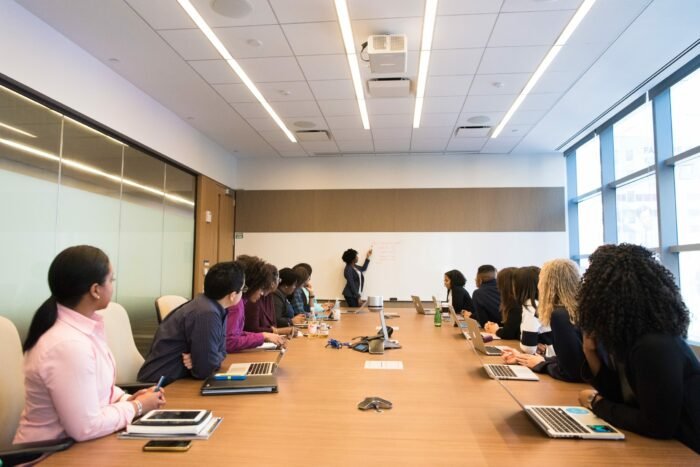Understanding and shaping organizational culture is essential for companies to thrive in today’s competitive business landscape. Culture mapping provides a valuable framework for analyzing and improving workplace culture. By mapping the existing culture, organizations can identify areas of strength, uncover gaps, and develop strategies for cultural transformation.
Culture mapping goes beyond a superficial examination of the company’s culture; it involves capturing the real culture from multiple perspectives, not just the CEO’s viewpoint. To ensure a comprehensive understanding of the culture, it is crucial to assemble a diverse team with varying levels of seniority, tenure, and perspectives.
The team responsible for culture mapping should consist of a core culture team, facilitation team, and participants who will work collaboratively to map the current organizational culture. In this process, the voices of all employees matter, and their inputs will provide valuable insights into the culture’s strengths and areas for improvement.
Organizational Culture Mapping Essentials
Key Takeaways:
- Culture mapping is crucial for organizations to understand and improve their workplace culture.
- A diverse team with varying perspectives is essential for effective culture mapping.
- Culture mapping involves capturing the real culture from multiple perspectives.
- The core team, facilitation team, and participants work together to map the organizational culture.
- The insights gained from culture mapping can drive organizational change and facilitate cultural transformation.
Building a Diverse Team for Culture Mapping
Before embarking on the culture mapping process, it is crucial to assemble a diverse team that includes the culture design team, facilitation team, and participants. The culture design team plays a vital role in shaping the overall strategy and implementing the culture design process. To ensure a wide range of perspectives, a team size of 5-7 members is recommended to avoid groupthink and promote diversity of thought.
The facilitation team is responsible for designing and facilitating the culture mapping sessions. Their expertise in guiding discussions and activities throughout the process is instrumental in achieving meaningful insights. Finally, the participants, who provide their impressions and viewpoints on the company culture, play a crucial role in capturing the multiple perspectives necessary for an accurate culture map.
The diverse composition of the team enables the gathering of insights from different groups and perspectives. This diversity fosters creativity, challenges assumptions, and promotes a more comprehensive understanding of the organization’s culture.
Benefits of a Diverse Team
A diverse team brings several advantages to the culture mapping process:
- Varied perspectives: Different backgrounds and experiences contribute to a more comprehensive understanding of the company culture.
- Prevention of bias: The inclusion of diverse voices helps mitigate individual biases and blind spots, ensuring a more accurate culture map.
- Creative problem-solving: Diverse teams tend to generate more innovative solutions, leading to richer insights and actionable recommendations.
- Inclusion: Building a diverse team fosters a culture of inclusivity and demonstrates a commitment to valuing different perspectives.
Example of a Diverse Team Composition
In a culture mapping initiative, the team composition could include individuals from various departments, levels of seniority, and tenure within the organization. For instance:
| Team Member | Role | Department | Seniority | Tenure |
|---|---|---|---|---|
| Emily | Culture Design Lead | Human Resources | Senior | 5 years |
| Alex | Facilitation Expert | Organizational Development | Junior | 2 years |
| Noah | Participant | Marketing | Mid-level | 10 years |
| Sophia | Participant | Finance | Senior | 3 years |
| Liam | Participant | Operations | Junior | 1 year |
| Olivia | Participant | Engineering | Mid-level | 7 years |
This diverse team composition enables a wide range of perspectives and insights, contributing to a more accurate and holistic culture map.
Defining the Right Participants for Culture Mapping
When it comes to culture mapping, selecting the right participants is crucial for gaining valuable insights and ensuring a comprehensive representation of the organization’s culture. Here are some key considerations when defining the participants:
- Extreme Users: Include individuals who represent unique perspectives and experiences within the organization. These extreme users can provide valuable insights that may not be captured by the average participant.
- Composition of Different Groups: Form diverse groups based on factors such as tenure, seniority, background, and functional areas. This ensures a comprehensive understanding of the organization’s culture from various angles and perspectives.
- Realistic Representation: Each group should ideally reflect the diversity and complexity of the organization. This means including participants from different departments, levels of seniority, and backgrounds to ensure a realistic representation of different perspectives.
In addition, international companies should consider conducting culture mapping sessions with key countries to compare cultures across different offices. This provides valuable insights into cultural differences and similarities, allowing for more targeted culture design strategies. Managing the composition of different participant groups should be entrusted to skilled facilitators, who can ensure meaningful contributions from each participant and maintain a balanced representation of perspectives.
By carefully defining the participants for culture mapping, organizations can gather rich insights into their culture and make informed decisions on how to enhance and shape their workplace culture.
Preparing for Culture Mapping Session
Prior to the culture mapping session, it is crucial to gather all relevant information and documents related to the company culture. This includes purpose, values, culture surveys, and company rules and policies. These materials serve as a foundation for understanding the current culture and provide valuable insights for the mapping process.
To ensure participants are well-prepared and gain a comprehensive understanding of the culture mapping process, it is essential to provide them with pre-work exercises and introductory materials. These resources familiarize participants with the concepts and methodologies involved, enabling them to approach the session with a deeper level of engagement and knowledge.
Pre-work Exercises
The pre-work exercises are designed to encourage participants to reflect on their experiences and perceptions of the company culture. These exercises may include questionnaire-style assessments, reflection prompts, or interactive activities that help individuals identify their values, behaviors, and expectations within the workplace.
By engaging in these pre-work exercises, participants are better equipped to articulate their thoughts and contribute meaningfully during the culture mapping session.
Introductory Materials
I’ve found that providing participants with introductory articles or videos on culture mapping can be highly beneficial. These resources offer an overview of the process, explain its importance, and illustrate real-world examples to inspire participants’ creativity and critical thinking.
The purpose of these materials is not to influence participants’ opinions or perceptions of the culture but instead to provide them with a common understanding of the culture mapping process and its objectives. It is essential to emphasize that the mapping exercise aims to capture individuals’ true thoughts, feelings, and perceptions rather than relying solely on written documents. This ensures that the culture mapping session reflects the reality of the culture as experienced by the people within the organization.
As the image above illustrates, the pre-work phase is a critical step in the culture mapping journey. It sets the stage for meaningful discussions and uncovers insights that are essential for a comprehensive understanding of the organizational culture.
Facilitating a Culture Mapping Session
When it comes to conducting a culture mapping session, one effective approach is to utilize the Culture Design Canvas. This powerful tool consists of 10 building blocks that are categorized into the core, emotional culture, and functional culture. To begin the session, we recommend that each participant creates an individual draft version of the canvas. This step allows for personal reflection and initial thoughts.
After this individual exercise, the facilitation team can guide the participants as they collectively work on each building block. The team should start with the core, focusing on defining the organization’s purpose, core values, priorities, as well as the behaviors that are rewarded and punished. This block sets the foundation for the desired culture.
Next, attention can be turned to the emotional culture building block. Here, elements such as psychological safety, feedback processes, and rituals come into play. By addressing these aspects, the team can gain insights into the emotional drivers that shape the organization’s culture.
The last building block to be tackled is the functional culture. This block involves examining the norms, rules, decision-making processes, and meeting dynamics within the organization. Understanding and evaluating these components is key to comprehending how work gets done and how the culture functions on a practical level.
The goal of the culture mapping session is to create a first draft of the Culture Design Canvas that encompasses any contradictions and unclear aspects identified. Once the initial draft is complete, the team can revisit the canvas to find common ground, identify areas of agreement, and pinpoint potential areas for improvement.
To visualize this process, here is an example of a completed Culture Design Canvas based on a hypothetical company:
| Core | Emotional Culture | Functional Culture |
|---|---|---|
| Purpose: Creating innovative solutions | Psychological Safety: Encouraging diverse perspectives | Norms and Rules: Promoting collaboration |
| Core Values: Integrity, Excellence, Collaboration | Feedback: Providing constructive feedback regularly | Meetings: Efficient and inclusive decision-making |
| Priorities: Customer satisfaction, Employee development | Rituals: Celebrating achievements and milestones | Decision-Making: Involving relevant stakeholders |
| Rewards and Punishments: Recognizing achievements, addressing misconduct |
This completed canvas showcases the various building blocks and their corresponding elements. It provides a visual representation of the organization’s culture, highlighting the core values, emotional drivers, and functional aspects that shape the workplace environment.
By following this approach, organizations can effectively facilitate culture mapping sessions, allowing for a comprehensive understanding of their current culture and enabling them to work towards a more aligned and purpose-driven future.
Applying the Culture Map Insights
Once the culture mapping process has provided valuable insights into your organization’s culture, it’s time to put those insights to work. These insights can help you gain a deeper understanding of your organizational culture, identify areas for improvement, and drive positive change.
However, it’s important to recognize that culture is a complex and adaptive system. Changing it directly can be challenging and requires a thoughtful approach. Instead, the insights from culture mapping should be used to initiate conversations, ignite curiosity, and start discussions on how to improve your organizational culture.
By leveraging the culture map insights, you can:
- Facilitate open and honest conversations about the current culture
- Identify areas where the culture may not align with organizational goals
- Highlight strengths and opportunities for growth within the culture
- Generate ideas for fostering a more inclusive and collaborative environment
To maximize the impact of the culture map insights, consider applying them at different levels within your organization. This can include:
- Engaging individual teams in discussions about their team culture and how it aligns with the broader organizational culture
- Bringing together management or leadership teams to explore how their actions and decisions shape the culture
- Comparing your organization’s culture with that of competitors to gain a competitive edge
Remember, the goal is not to change the culture overnight, but to spark meaningful conversations and drive a cultural transformation strategy. Each step taken towards aligning your organizational culture with your desired future state can contribute to a more positive and thriving workplace.
By applying the insights gained through culture mapping, you can create a cultural transformation strategy that fosters a positive and inclusive workplace culture.
Conclusion
In conclusion, the Culture Design Canvas is an invaluable tool for organizations to assess and map their organizational culture. By utilizing this culture mapping tool, companies can gain a deeper understanding of their current culture, define future states, and actively work towards developing a positive workplace culture. Through the mapping process, organizations can achieve clarity, foster alignment, and uncover areas for improvement and growth.
To successfully map the culture using the Culture Design Canvas, it is crucial to assemble a diverse team, adequately prepare for the session, facilitate the mapping session effectively, and apply the insights gathered. This ongoing process fosters a culture of continuous improvement and can play a significant role in driving positive organizational change.
By utilizing the Culture Design Canvas, organizations can take proactive steps towards building a positive workplace culture that aligns with their values and goals. This tool empowers companies to assess their culture objectively, identify areas in need of development, and implement strategies to foster a more inclusive and engaging work environment. Ultimately, the Culture Design Canvas facilitates the creation of a positive workplace culture that enhances employee satisfaction and productivity, and contributes to overall organizational success.
FAQ
What is culture mapping?
Culture mapping is the process of understanding an organization’s current culture, identifying gaps, and prioritizing actions for improvement.
Why is culture mapping important?
Culture mapping is important because it helps organizations gain clarity, facilitate alignment, and uncover areas for development in their workplace culture.
How do you build a diverse team for culture mapping?
Building a diverse team for culture mapping involves assembling a culture design team, facilitation team, and participants who provide unique insights and perspectives.
How do you define the right participants for culture mapping?
The right participants for culture mapping should include extreme users and individuals from diverse groups based on tenure, seniority, background, and functional areas.
How do you prepare for a culture mapping session?
To prepare for a culture mapping session, gather relevant information and documents related to the company culture and provide participants with pre-work exercises and materials.
How do you facilitate a culture mapping session?
Facilitating a culture mapping session involves using the Culture Design Canvas, working as a team on each building block, and creating a draft version that incorporates contradictions and unclear aspects.
How do you apply the insights from culture mapping?
The insights from culture mapping can be used to initiate conversations, raise curiosity about organizational culture, and start discussions on how to improve it.
What is the Culture Design Canvas?
The Culture Design Canvas is a valuable tool for assessing and mapping organizational culture, providing a framework to understand current culture and develop workplace culture.
![Organizational Culture Mapping Essentials [Best 4] 1 pexels alena darmel 7710141 scaled e1705648449101](https://zoets.b-cdn.net/wp-content/uploads/2024/01/pexels-alena-darmel-7710141-scaled-e1705648449101.jpg)
![Organizational Culture Mapping Essentials [Best 4] 2 Building a Diverse Team for Culture Mapping](https://zoets.b-cdn.net/wp-content/uploads/2024/01/pexels-kampus-production-5940838-1024x683.jpg)
![Organizational Culture Mapping Essentials [Best 4] 3 Facilitating a Culture Mapping Session](https://zoets.b-cdn.net/wp-content/uploads/2024/01/pexels-theo-decker-5946214-1024x683.jpg)







![How to Improve Employee Welfare? [7 Ways] 11 How to Improve Employee Welfare](https://zoets.b-cdn.net/wp-content/uploads/2024/02/pexels-alexander-suhorucov-6457577-scaled-e1708707251724.jpg)
![Saudi Oil Industry Key Stats Unveiled [2024] 12 Saudi Oil Industry Key Stats](https://zoets.b-cdn.net/wp-content/uploads/2024/02/h.jpg)